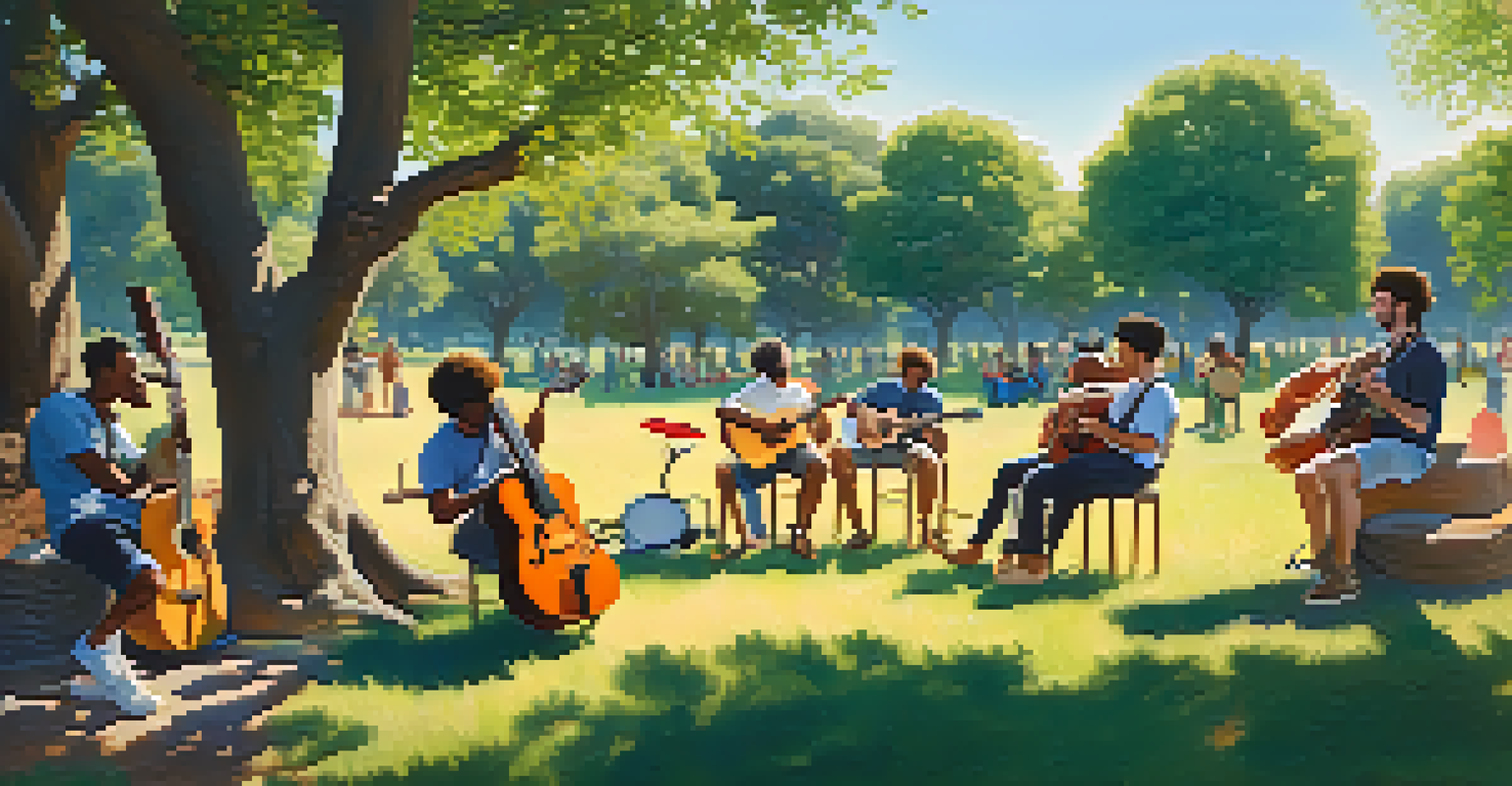Intermediate Guitar Skills: Building on Your Basic Techniques

Understanding Intermediate Guitar Techniques and Their Importance
As you progress on your guitar journey, understanding intermediate techniques becomes crucial. These skills not only enhance your playing but also open up new musical possibilities. Think of it as learning to swim deeper in the ocean of music; the more skills you have, the further you can explore.
Music is the shorthand of emotion.
Intermediate techniques like fingerpicking, barre chords, and scales allow you to express yourself more fully. They provide the tools needed to tackle a wider range of songs and styles. Plus, they help you develop a solid foundation for advanced techniques later on.
By embracing these intermediate skills, you'll find that your confidence grows alongside your playing ability. It’s not just about hitting the right notes; it’s about conveying emotion and storytelling through your music.
Mastering Barre Chords: A Key Intermediate Technique
Barre chords are often seen as a rite of passage for intermediate guitarists. While they can be challenging at first, mastering them greatly expands your chord vocabulary. Imagine being able to play any major or minor chord anywhere on the neck—it's like having a secret weapon in your musical arsenal.

To get started, focus on the basic E and A shape barre chords. Practice switching between these shapes to build muscle memory. It might take some time, but with persistence, you’ll find that your fingers become more comfortable with the positions.
Intermediate Techniques Expand Skills
Understanding techniques like fingerpicking, barre chords, and scales enhances your playing and opens up new musical possibilities.
Once you’ve got a handle on barre chords, you’ll be able to play a multitude of songs that were previously out of reach. This skill not only enhances your versatility but also boosts your confidence, making you feel like a true guitarist.
Exploring Fingerpicking Techniques for Depth and Texture
Fingerpicking is a beautiful technique that adds depth and texture to your playing. It allows for a more intricate sound and can really elevate simple chords into something special. Imagine strumming a chord and then plucking individual strings to create a melody that dances around the harmony.
The beautiful thing about learning is that no one can take it away from you.
Start by practicing simple patterns, like alternating bass notes with melody strings. This will help you develop control and coordination between your fingers. As you get comfortable, try incorporating more complex patterns and rhythms to challenge yourself.
Fingerpicking opens up a whole new world of musical expression. You’ll find that many genres, from folk to classical, use this technique, allowing you to explore different styles and sounds.
Scales: The Building Blocks of Melodic Improvisation
Scales are often considered the building blocks of music and are vital for improvisation. They help you understand the relationship between notes and chords, giving you the ability to create melodies on the fly. Think of scales as a roadmap; they guide you through the musical landscape.
Start with the major and minor scales, as they form the foundation for many songs. Practice them in different positions on the fretboard to familiarize yourself with the notes. As you gain confidence, explore pentatonic and blues scales, which are particularly useful for improvisation.
Rhythm Is the Heartbeat of Music
Focusing on rhythm and timing is essential for creating cohesive and engaging music that resonates with listeners.
By mastering scales, you’ll not only improve your soloing skills but also gain a deeper understanding of music theory. This knowledge will empower you to express yourself more freely on the guitar.
Developing Rhythm and Timing: The Heartbeat of Music
Rhythm and timing are often overlooked by beginners but are essential for any intermediate guitarist. They form the backbone of music, ensuring that your playing feels cohesive and engaging. Think of rhythm as the heartbeat of your music—without it, everything loses its pulse.
Use a metronome to practice playing in time, gradually increasing the tempo as you become more comfortable. Experiment with different strumming patterns and syncopation to add variety to your playing. This will not only improve your timing but also make your music more dynamic.
By focusing on rhythm, you'll develop a greater sense of musicality. You'll find that your playing becomes more expressive, drawing listeners in and making them feel the groove.
Chord Progressions: Crafting Your Own Songs
Learning to create your own chord progressions is an exciting step for intermediate players. It allows you to express your musical ideas and emotions through original compositions. Imagine being able to craft a song that reflects your unique experiences and feelings—it's empowering!
Start by experimenting with common progressions like I-IV-V or ii-V-I. Play around with different keys and tempos to see how they change the mood of your music. Don’t hesitate to mix major and minor chords to create tension and resolution.
Collaboration Enhances Musical Growth
Playing with other musicians fosters skill development and deepens your appreciation for different musical styles and dynamics.
As you gain confidence in writing progressions, consider adding melodies on top. This combination of chords and melodies is the essence of songwriting, and it’s a skill that will serve you well as you continue your musical journey.
Playing with Other Musicians: The Joy of Collaboration
Playing with other musicians is one of the most rewarding experiences for any guitarist. It not only enhances your skills but also helps you develop a sense of timing and dynamics. Imagine the excitement of jamming with friends or performing in front of an audience—it's truly exhilarating!
Start by finding local jam sessions or joining a band to get comfortable playing with others. Pay attention to how you fit into the overall sound, whether you're accompanying or taking the lead. This collaboration will push you to adapt and grow as a musician.

Through collaboration, you'll learn the importance of listening and communication in music. These skills will not only improve your playing but also deepen your appreciation for different musical styles and perspectives.